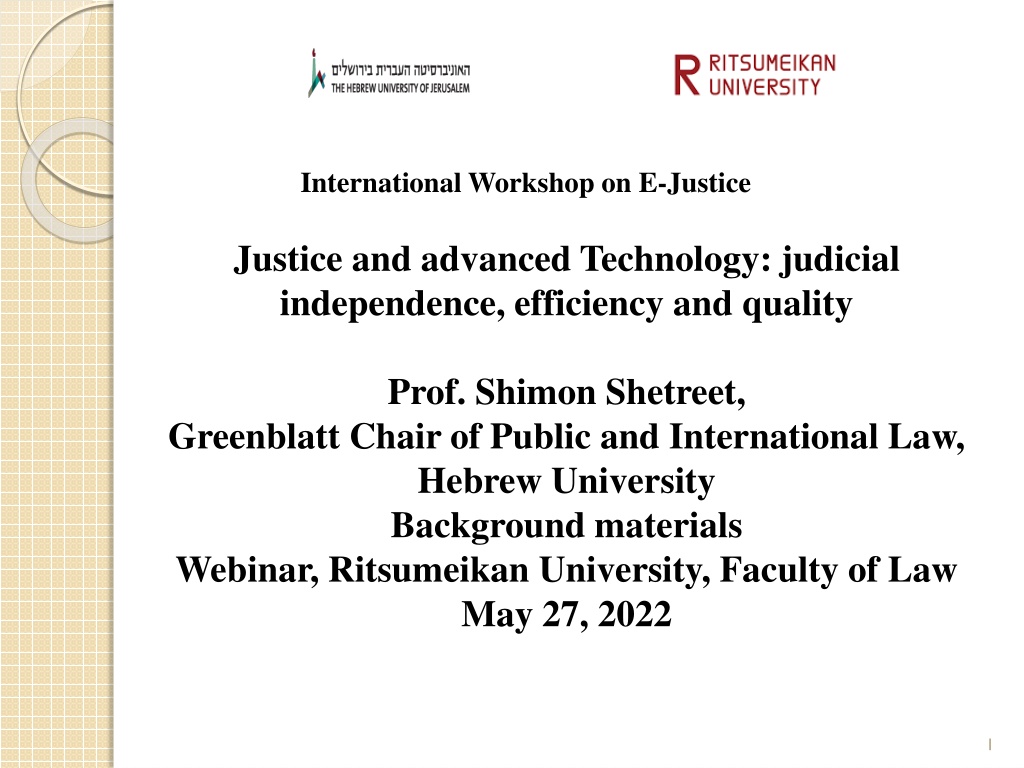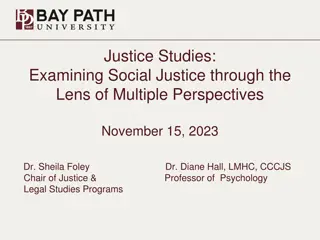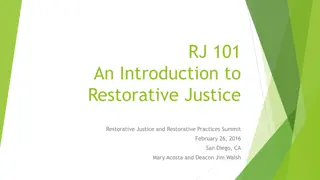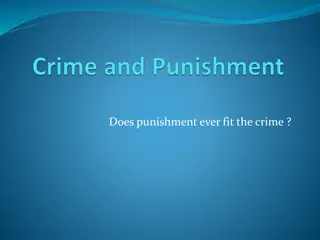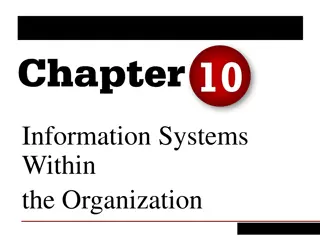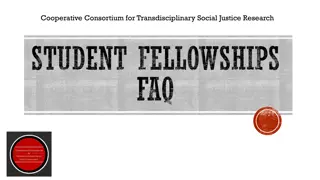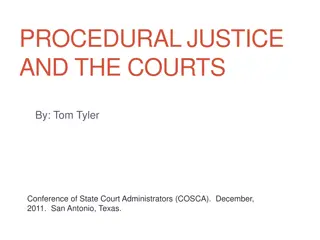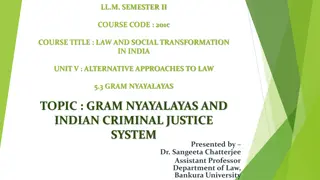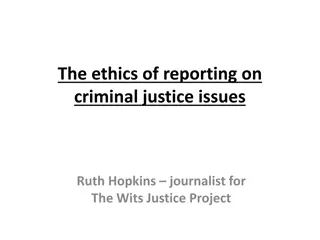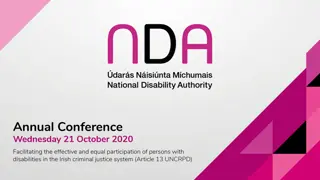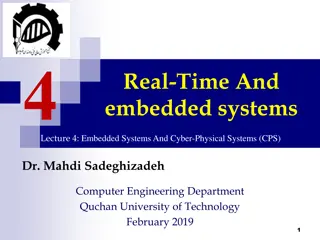Challenges and Opportunities in Modern Justice Systems
Delve into the intersection of justice, technology, and fundamental values in today's legal landscape. Explore vital aspects such as jurisdiction, legal system application, investor safeguards, and the economic value of justice systems. Uncover the significance of judicial independence, fairness, efficiency, public confidence, and access to justice amid challenging realities like constitutional and budgetary constraints. Discover the evolving role of advanced technology, including the use of DNA in criminal procedures, digitalization of judicial processes, and the impacts of artificial intelligence on adjudication.
Download Presentation

Please find below an Image/Link to download the presentation.
The content on the website is provided AS IS for your information and personal use only. It may not be sold, licensed, or shared on other websites without obtaining consent from the author.If you encounter any issues during the download, it is possible that the publisher has removed the file from their server.
You are allowed to download the files provided on this website for personal or commercial use, subject to the condition that they are used lawfully. All files are the property of their respective owners.
The content on the website is provided AS IS for your information and personal use only. It may not be sold, licensed, or shared on other websites without obtaining consent from the author.
E N D
Presentation Transcript
International Workshop on E-Justice Justice and advanced Technology: judicial independence, efficiency and quality Prof. Shimon Shetreet, Greenblatt Chair of Public and International Law, Hebrew University Background materials Webinar, Ritsumeikan University, Faculty of Law May 27, 2022 1
The Justice System and Economic Growth and International Trade 1. Which Countries Have Jurisdiction 2. Which Legal System Should be Applied 3. Are there safeguards for investors 4. Is there access to the legal system 5. The independence and impartiality of dispute resolution mechanism ,courts arbitration tribunals 6. Economic Value of the Justice System (over 2% of loss of GNP due to deficiencies of the judicial system) 2
Fundamental Values 1. Review of the Justice system in modern times must give attention to fundamental values. 2. The fundamental values which lie at the foundation of the Justice System (courts and arbitration) include: 3
The Fundamental Values 1. Judicial Independence and Impartiality 2. Fairness and Justice 3. Efficiency 4. Maintaining Public Confidence in the Court 5. Access to the Judicial System 6. Transparency 7. Accountability 8. Constitutionalism 4
Challenging Realities 1. Constitutional Challenges 2. Budgetary challenges 3. Efficiency by Technology versus Judicial Independence 4. Court delays 5. Caseload crisis 5
Justice and advanced technology - The recourse to DNA in criminal procedure - Digitalization of the judicial procedure - Digitalization must be qualified to allow alternative manual procedures, for those who are unable to use online methods. - The increased of use of remote trials, and virtual justice, following the Covid-19 Pandemic. - Virtual justice has many disadvantages the continued use after the pandemic should be done very carefully. * Personal conduct is not sufficiently appreciated * Not everyone have internet and communication system. *The collegiality of the judicial panel is impacted *The quality of the decision is influenced 6
Artificial intelligence in the courts - The use of artificial intelligence (AI) for adjudication The need to regulate algorithm decision-making system, and algorithm judicial decision. See for Example: ELI Model Rules on Impact Assessment of Algorithmic Decision-Making Systems Used by Public Administration (2022) - The increase recourse to technology, is the result of emphasis on standardization of efficiency accessibility and consistency. These values and considerations, conflict with the need for judicial discretion and the value of quality and independence in individual cases which standardization may fail to take into account 7
The dilemma of conflicting values: Justice versus Efficiency Production of Justice cannot be done in the same standards of industrial production In a an Israeli Supreme Court ruling, Administrative Appeal 3908/11 State of Israel and Court Administration v. The Marker Haaretz , Justice Chayut said: The concern towards the functionality of the Judicial Branch that my colleague, Justice Arbel raised in her opinion, as well as my brethren, Justices Hendel and Rubinstein in their opinion are very disturbing and merit attention... 8
Justice versus Efficiency It is especially disturbing to me the concern that the emphasis on the efficiency of the judicial branch and the publication of cases pending before individual judges may breath down the necks of the judges and may push them to accelerate the hearings and the judgement at the expense of their quality. After all, Judges are not a production line for verdicts. My colleague noted this and stated: the judge cannot exercise his duty qualitatively, and to its fullest when in one hand he holds a hammer and in the other a stopwatch . Indeed, it is important to remember that efficiency is not everything and as such, evaluating the activity of the Judicial Branch based on production and productivity may distance the judicial discourse from its essence, which is the heart of this practice, doing justice... 9
Justice versus Efficiency Regarding this are words written by the scholar, Professor Shimon Shetreet more than 30 years ago which still hold true today: since the purpose of the judicial process and the justice system is making justice, we must take care to not examine it by production and productivity, and to apply to it haphazardly terms of efficiency from different areas and management. 10
Indicators of Justice There are several organizations that measure international standards of Judicial independence a. EU Scoreboard of justice system and the rule of law b. European Commission for the Efficiency of Justice(CEPEJ) c. Human Development Index d. World Economic Forum e. The World Bank f. World Justice Project Open Index 11
EU Scoreboard of Justice System and the Rule of Law Effective justice systems are a necessity for upholding the rule of law and EU founding values, mutual trust, investments and long-term growth. National courts act as EU courts when applying EU law and are the first to ensure its effective enforcement. The EU Justice Scoreboard s annual overview of indicators of effective justice systems: I. Efficiency II. Quality III.independence 12
Efficiency An efficient justice system manages its caseload and backlog of cases, and delivers its decisions without undue delay. Indicators of efficiency: I. Length of proceedings (time to resolve a case) II. Clearance rate (resolved over incoming cases) III.Pending cases (cases remains to be dealt with) 13
Efficiency Findings Across 2012-2019 and regarding civil, commercial and administrative cases efficiency has improved or remained stable in 10 Member States and decreased in 9 Member States. Almost all Member States saw a decrease in the length of the first instance of court proceedings in at least one category. Overall, half of them saw a total decrease. Majority of Member States reported high clearance rates (above 97%). Large variations appear in the clearance rates of administrative cases. More than half of the Member States facing challenges reported an increase in the clearance rate. There is a significant difference between Member States regarding pending cases. 14
Quality Easy access, sufficient resources, effective assessment tools and digitalization are the factors that contribute to a high quality of justice systems. I. Accessibility: legal aid, fees, alternative dispute resolution methods and child- friendliness. II. Resources: financial and human resources, infrastructure, appropriate training and diversity. III. AssessmentTools: use of surveys. IV. Digitalization: online information and access to cases, digital-ready procedural rules, use of technology by courts and secure means of communication 15
Quality Findings Accessibility In some Member States, consumers below the poverty threshold would not receive legal aid. Legal aid was tightened in a third of the Member States and widened in 5 of them. Level of court fees has remained largely stable. Two Member States have no court fees for commercial litigation. 17 Member States provide the option to initiate a proceeding, file a claim or submit evidence online. In 19 Member States, parties can be informed of procedure steps online. 12 Member States allow for online payment of fees. In 8 Member States chatbots and AI assistant technologies are available. All Member States make some accommodations to make the court child-friendly. 16
Quality Findings Resources Almost all Member States increased their expenditure on courts financial resources per capita. A majority also increased the expenditure as percentage of GDP. In most Member States, wages and salaries represents the biggest share of the expenditure. Proportion of women judges at Supreme Courts has risen, although still standing on less than 50%. Few Member States offer judges training on IT skills, management and ethics. Most Member States provide training concerning victims of gender-based violence and gender sensitive practices, asylum seekers, people of different culture, religion or language or with visually or hearing impairment. Assessment Tools The use of surveys slightly increasing along the years with a stable number of Member States 17 not conducting surveys at all.
Quality Findings Digitalization: Almost all Member States provide access to some online information. 12 Member States allow for online simulations of one s eligibility for legal aid. Online forms and information for non-native speakers is available in most of the Member States. Less than half of the Member States have digital-ready procedural rules. Most Member States have digital management, videoconferencing and teleworking systems. 17 Member States publish all civil, commercial and administrative judgments online. 15 Member States also publish highest instance criminal judgments. Few Member States publish second instance judgments. 18
Independence Judicial independence is a fundamental element of an effective justice system, vital for the rule of law, the fairness of proceedings and the trust in the legal system. Therefore, any justice reform should uphold the rule of law and comply with European standards on judicial independence. 19
Independence Findings Perception of independence has improved in over 2/3 of Member States and 3/5 of the Member States facing challenges compared to 2016. Compared to last year, perceived independence have decreased in half of the Member States. The interference or pressure from government and politicians was the most stated reason for the lack of independence. About 40% of respondents stated the guarantee provided by the status and position of judges as a reason for high independence. In most Member States the independence of lawyers is guaranteed. 20
EU Scoreboard of Justice System and the Rule of Law Conclusions The 2021 EU Justice Scoreboard shows a continued improvement in the effectiveness of justice systems in large majority of Member States. The new dedicated section on the digitalization of justice systems, inspired by the COVID-19 global process, shows that most of Member States already have different digital tools at the disposal of courts, but significant room for improvement remains. Challenges remain to ensure full trust of citizens in the legal systems of Member States where guarantees of status and position of judges, and thereby their independence, might be at risk. The information contained in the EU Justice Scoreboard contributes to the monitoring carried out in the framework of the European Rule of Law 21 Mechanism and feeds into the Commission s annual Rule of Law Report.
b. European Commission for the Efficiency of Justice (CEPEJ) The CEPEJ measures many factors that may indicate the efficiency of justice Court Budgets and Income generated by the courts I. II. Access to courts and Legal Aid III. Confidence in the Courts IV. Lawyers and Judges V. Execution of court decisions 22
Indicators of Justice c. Human Development Index This organization uses life expectancy, expected years of schooling and national income per capita to see what policies should be enacted. d. World Economic Forum Ranks different aspects of governmental institutions such as: public trust of politicians; division of public funds; government spending and more. These rankings allow us to see where Justice is lacking in a certain country. 23
Indicators of Justice E. Each year a report, Doing Business , is published facilitating and promoting the establishment of businesses. A country can learn from the others to better regulate businesses. The 2013 survey found that economies that improve in areas measured by Doing Business are on average more likely than others to also implement reforms in other areas such as: governance; health; education and gender equality. The World Bank The 2015 annual report examined 34 countries and determined how much Freedom of Contract each country had. The results show that all 34 economies have struck a balance between extreme interference and extensive freedom of contract, as well as reflecting a consensus on certain limitations that should be imposed. 24
Indicators of Justice F. This is the first effort to measure government openness based on the perceptions and experiences of the general public. The index presents aggregated scores and rankings as well as individual scores for each of the following dimensions of government openness: publicized laws and government data; right to information; civic participation and complaint mechanisms. oThe results show that 50% of people aren t aware of their right to information and that on the whole men are more aware than women. World Justice Project Open Index 25
CEPEJ Report 2014 1. European countries spend on average 35 Euro per capita on the court system 2. Income fees may amount to a very small amount of the Court budget, or in some cases almost 50% of the budget. 3. The average clearance rate in European countries is 98.9%. 4. On average there are 151.3 lawyers (per 100,00 citizens) in European countries. 1. Israel on the other hand has 636.9. 26
Indicators of Justice A. All the different organizations measuring the different levels of Justice allow for an overview on the Macro level, allowing us to discern different trends and what we can do to change the direction of our own countries. B. Developing and encouraging such databases in Asian countries are essential to globalize trade in that part of the world . 27
Just as a background we should mention also the Indicators of Democracy and The Rule of Law Detailed in the Mt. Scopus standards 1.5-1.5.3 Text of the Amendments to the Mount Scopus International Standards of Judicial Independence adopted in London 2018: Article 1.5 added to the Mount Scopus International Standards 1.5Foundations of Democracy and the Rule of Law 1.5.1 For culture of judicial independent to be maintained and preserved it is essential to safeguard and protect central foundations of democracy and the rule of law. 1.5.2 Further to the resolution and recommendations of leading international organizations, it is significant to require national jurisdictions to respect certain fundamental foundations of democracy and rule of law
1.5.3 These essential foundations of democracy and rule of law include the following foundations: (a) Legality - Supremacy of the law, Compliance with the law, Relationship between international law and domestic law, Law- making powers of the executive, Law-making procedures, Exceptions in emergency situations, Duty to enforce the law, Private actors in charge of public tasks (b)Legal certainty - Accessibility of legislation, Accessibility of court decisions, Foreseeability of the laws, Stability and consistency of law, Legitimate expectations, Non-retroactivity, Res judicata (c) Prevention of abuse (misuse) of powers (d) Equality before the law and non-discrimination - including Equality in law
(e) Independence and impartiality of the justice system - Independence and impartiality, Independence of the judiciary, Independence of the individual judges, Impartiality of the judiciary, prosecution service: autonomy and control, Independence and impartiality of the Bar (f) Fair trial - Access to courts, Presumption of innocence, aspects of the right to a fair trial, Effectiveness of judicial decisions (g) Constitutional and administrative judicial review (h) Substantive rule of law democracy and respect of democratic minority groups (i) Maintenance and respect of effective opposition in parliament and in the streets
(j) Protection of the freedom of the press and all forms of electronic and digital and social media and limited government control on private and public media institutions (k) Protection of activities of civil society groups and non- governmental organisations (l) Maintenance of the principle of civilian supremacy of military and security authorities (m) Respect the separation of powers (n) Respect of human rights, including political and civil rights and social and economic human rights.
For Enforcement and Recognition of Foreign Judgements and Arbitral Awards the independence and integrity of the tribunal is reviewed by the foreign tribunal 1. In times of cross border trade and transnational economy courts must apply not only their own legal system but in some instances apply the legal doctrine of a foreign state. 2. A court may also be asked to enforce an award or judgement given by a foreign court. 32
Enforcement and Recognition of Foreign Judgements and Awards 3. Before recognizing a foreign decision the court must decide whether the foreign court is fair and just. 4. The decision depends on two factors: a. Independence b. Integrity 33
Enforcement and Recognition of Foreign Judgements and Awards Yukos Capitol Sarl v OJSC Rosneft oil Co. (2012): 1. The Russian arbitration court made a decision in the case. 2. The Dutch court decided that the Russian decision was made by a non-independent body and was therefore not enforceable. Should the English court accept the Dutch decision or should they come to their own decision? 1. The Court of Appeals decided that the English must look at the Russian court itself and not rely on the Dutch decision (no estoppel) because the criterion for judicial independence may differ by country. 34
Enforcement and Recognition of Foreign bJudgements and Awards Merchant International Co. Ltd. v. Nationalna Kompaniia Naftogaz Ukrainy (2012) 1. The English court recognized a Ukrainian judgement. 2. Following the English courts recognition, the Ukrainian courts reversed their original decision. Should the English court set aside its initial recognition after the reversal in the Ukraine? 1. The English court of appeals decided not to disregard their original decision, as they viewed the Ukrainian reversal as illegitimate, in violation of the rule of law . 35
Is agencification de facto a violation of the rule of law principle? Usurpation 1. If the court administration is an independent organ, is it not contrary to the law? 2. Introduction of this model earlier rejected by the system (Kedmi and Matsa commities) 36
Creating a Culture of Judicial Independence: A wider conception The culture of judicial independence is created by five important and essential aspects: 1. creating institutional structures 2. establishing constitutional infrastructure 3. introducing legislative provisions and constitutional safeguards 4. creating adjudicative arrangements and jurisprudence 5. maintaining ethical traditions and a code of judicial conduct. 6. Emphasis on informal as well as formal arrangements 37
Relationship of the Judiciary and the Executive and Legislative: The Preferred Model Partnership and Dialogue The Principle of Mutual Respect between the Branches of Government Post Decisional Independence: Legislative Reversal of Judicial Decisions and Executive Enforcement of Judgments Executive Delegated Legislation and Preemptive Actions in Pending Matters before the Courts Judicial Role in Society Procedural Tools and Substantive Tests for Fine Tuning of Judicial Roles in Society 38
Conclusions Important to balance between an efficient Justice System and judicial independence II. It is essential to maintain the fundamental values of justice III. In the conflict between Efficiency and Fairness- fairness should win IV. Importance of judicial independence impartiality and fairness for enforcement of judgements in other jurisdictions I. 39
Conclusions Adapting an appropriate model of responsibility of court adminidtration according to local traditions and system of government II. Beware of managerial unrestrained powers in court management III. Essential foundation to insure efficiency: develop data base and collect data on justice system similar to European council EU Justice Scoreboard I. 40
Selected Sources Richard M.Re & Alicia Solow-Niederman Developing Artificially Intelligent justice 22 STAN. TECH. L. Rev 242 (2019) ELI Model Rules on Impact Assessment of Algorithmic Decision-Making Systems Used by Public Administration Lord Thomas, Reflections on the changing position of the judiciary in:S.Shetreet, H. Chodosh, E. Helland, Challenged justice in pursuit of judicial independence 17 (Brill-Nijhoff, 2021). Gianpaolo Maria Ruotolo, Judicial Independence Through Data-Driven Knowledge, Open Data, and Artificial Intelligence From a European Prespective, Ibid 159. Daniela Piana, Quality of Justice for Citizens: From Courts Standards to Equal Access for All, Ibid 123. I. II. III. IV. V. 41
Selected Sources VI. Shimon Shetreet ,Fundamental Values of the Justice System ,THE EUROPEAN BUSINESS LAWVOL 23 VII .SHIMON SHETREET, JUDGESON TRIAL: A STUDYOFTHE APPOINTMENTAND ACCOUNTABILITYOFTHE ENGLISH JUDICIARY xxii + 432 PP. (North Holland Publishing Co. ,1976). VIII. Shimon Shetreet and Sophie Turenne, JUDGES ON TRIAL: THE INDEPENDENCE AND ACCOUNTABILITY OF THE ENGLISH JUDICIARY, 2ND EDITION xxx+463 pp (Cambridge University Press 2013). IX .EU Scoreboard 2022 https://ec.europa.eu/info/sites/default/files/eu_justice_scoreb oard_2022.pdf pp 61-76 . ) 2012 ( 42
Selected Sources X. EU Scoreboard 2021 https://ec.europa.eu/info/sites/default/files/e u_justice_scoreboard_2021.pdf 43
